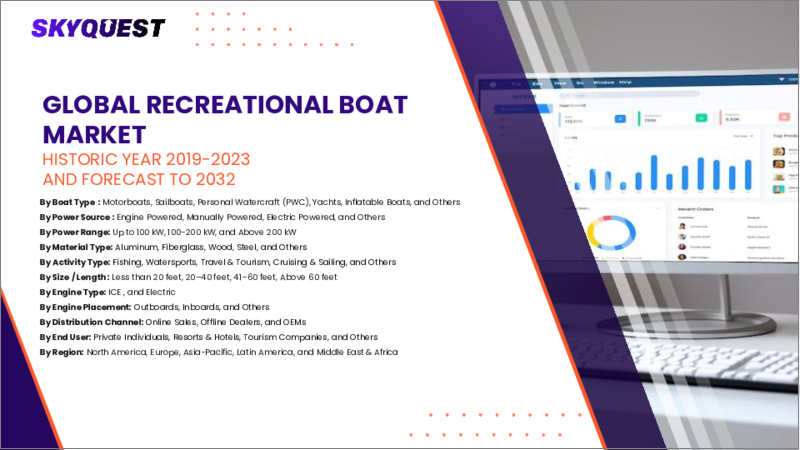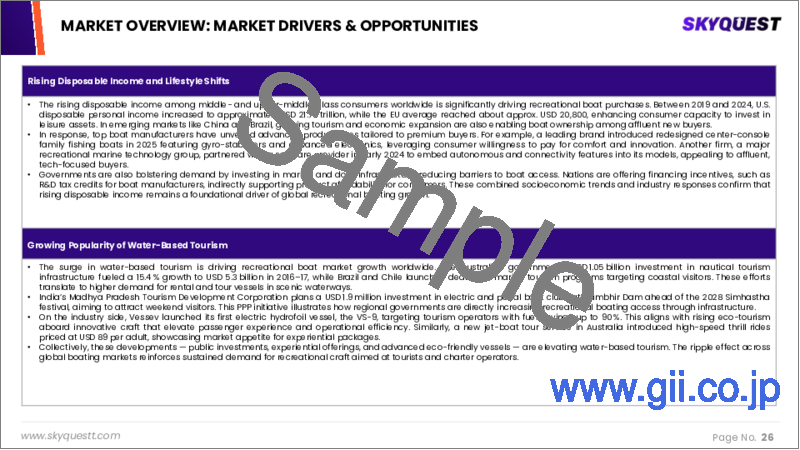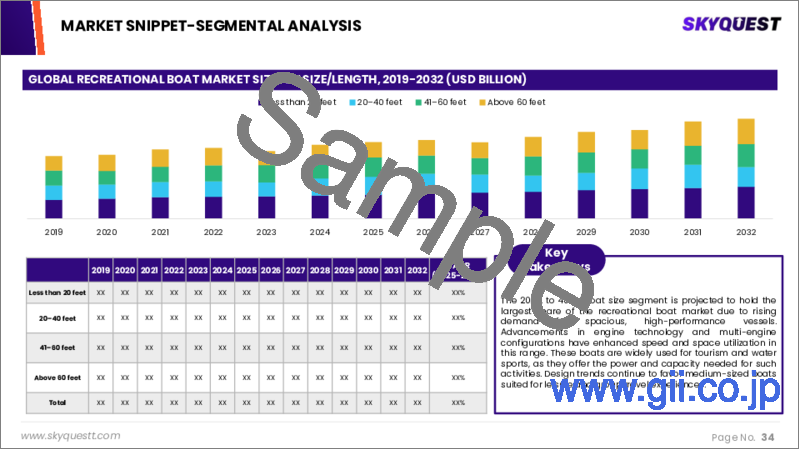|
|
市場調査レポート
商品コード
1636805
レクリエーショナルボートの市場規模、シェア、成長分析:ボートタイプ別、ボートサイズ別、エンジン配置別、エンジンタイプ別、パワーレンジ別、素材タイプ別、アクティビティタイプ別、動力源別、流通チャネル別、地域別 - 産業予測 2025~2032年Recreational Boat Market Size, Share, Growth Analysis, By Boat Type, By Boat Size, By Engine Placement, By Engine Type, By Power Range, By Material Type, By Activity Type, By Power Source, By Distribution Channel, By Region - Industry Forecast 2025-2032 |
||||||
|
|||||||
| レクリエーショナルボートの市場規模、シェア、成長分析:ボートタイプ別、ボートサイズ別、エンジン配置別、エンジンタイプ別、パワーレンジ別、素材タイプ別、アクティビティタイプ別、動力源別、流通チャネル別、地域別 - 産業予測 2025~2032年 |
|
出版日: 2025年01月17日
発行: SkyQuest
ページ情報: 英文 384 Pages
納期: 3~5営業日
|
全表示
- 概要
- 目次
レクリエーショナルボートの世界市場規模は、2023年に173億7,000万米ドルと評価され、2024年の185億米ドルから2032年には306億2,000万米ドルに成長し、予測期間(2025-2032年)のCAGRは6.5%で成長する見通しです。
世界のレクリエーショナルボート分野は、生活設備を備えた電動ボートの人気を特徴とする、ダイナミックで繁栄する海事産業であり続けています。これらのボートは、家族での遠出、釣り、ボートレース、ウォータースポーツ、セーリングなどに利用されることが増えており、多様な愛好家にアピールしています。同市場は、レクリエーションビジネスの急増と、旅客輸送や短距離輸送を含む商業用途でのボートの採用増加により、力強い成長を遂げています。さらに、レクリエーションボート競技は、エンジン式、帆船式、手動式など、さまざまなタイプのボートの参加を促進しています。コーティングされた布地、プラスチック、アルミニウムなどの素材がボートの建造に一般的に使用されていることから、この分野は進化する消費者の嗜好とレクリエーションの動向を活用するのに有利な立場にあります。
目次
イントロダクション
- 調査の目的
- 調査範囲
- 定義
調査手法
- 情報調達
- 二次データと一次データの方法
- 市場規模予測
- 市場の前提条件と制限
エグゼクティブサマリー
- 世界市場の見通し
- 供給と需要の動向分析
- セグメント別機会分析
市場力学と見通し
- 市場概要
- 市場規模
- 市場力学
- 促進要因と機会
- 抑制要因と課題
- ポーターの分析
主な市場の考察
- 重要成功要因
- 競合の程度
- 主な投資機会
- 市場エコシステム
- 市場の魅力指数(2024年)
- PESTEL分析
- マクロ経済指標
- バリューチェーン分析
- 価格分析
- 規制情勢
- ケーススタディ
- 技術の進歩
- 貿易分析
レクリエーショナルボート市場規模:ボートタイプ別& CAGR(2025-2032)
- 市場概要
- ヨット
- 帆船
- パーソナルウォータークラフト
- インフレータブル
- その他
レクリエーショナルボート市場規模:ボートサイズ別& CAGR(2025-2032)
- 市場概要
- 30フィート未満
- 30~50フィート
- 50フィート以上
レクリエーショナルボート市場規模:エンジン配置別& CAGR(2025-2032)
- 市場概要
- 船外機
- インボード
- その他
レクリエーショナルボート市場規模:エンジンタイプ別& CAGR(2025-2032)
- 市場概要
- ICE
- 電気
レクリエーショナルボート市場規模:パワーレンジ別& CAGR(2025-2032)
- 市場概要
- 最大100kW
- 100~200kW
- 200kW以上
レクリエーショナルボート市場規模:素材タイプ別& CAGR(2025-2032)
- 市場概要
- アルミニウム
- グラスファイバー
- 鋼鉄
- その他
レクリエーショナルボート市場規模:アクティビティタイプ別& CAGR(2025-2032)
- 市場概要
- クルージングウォータースポーツ
- 釣り
レクリエーショナルボート市場規模:動力源別& CAGR(2025-2032)
- 市場概要
- エンジン駆動
- 帆船動力
- 人力
レクリエーショナルボート市場規模:流通チャネル別& CAGR(2025-2032)
- 市場概要
- ディーラーネットワーク
- ボートショー
- オンライン販売
レクリエーショナルボート市場規模:地域別& CAGR(2025-2032)
- 北米
- 米国
- カナダ
- 欧州
- ドイツ
- スペイン
- フランス
- 英国
- イタリア
- その他欧州地域
- アジア太平洋地域
- 中国
- インド
- 日本
- 韓国
- その他アジア太平洋地域
- ラテンアメリカ
- ブラジル
- その他ラテンアメリカ地域
- 中東・アフリカ
- GCC諸国
- 南アフリカ
- その他中東・アフリカ
競合情報
- 上位5社の比較
- 主要企業の市場ポジショニング(2024年)
- 主な市場企業が採用した戦略
- 市場の最近の動向
- 企業の市場シェア分析(2024年)
- 主要企業の企業プロファイル
- 会社概要
- 製品ポートフォリオ分析
- セグメント別シェア分析
- 収益の前年比比較(2022-2024)
主要企業プロファイル
- Yamaha Motor Co., Ltd.(Japan)
- Groupe Beneteau(France)
- Malibu Boats, Inc.(USA)
- MasterCraft Boat Holdings, Inc.(USA)
- Azimut Yachts(Italy)
- Princess Yachts Limited(UK)
- Sunseeker International Ltd.(UK)
- Sea Ray Boats(USA)
- Boston Whaler(USA)
- Ranger Boats(USA)
- Lund Boats(USA)
- Tracker Boats(USA)
- Cobalt Boats(USA)
- Regal Boats(USA)
- Chaparral Boats, Inc.(USA)
- Formula Boats(USA)
- Grady-White Boats(USA)
結論と推奨事項
Global Recreational Boat Market size was valued at USD 17.37 billion in 2023 and is poised to grow from USD 18.5 billion in 2024 to USD 30.62 billion by 2032, growing at a CAGR of 6.5% during the forecast period (2025-2032).
The global recreational boating sector remains a dynamic and thriving maritime industry, characterized by the popularity of motorized boats equipped with living amenities. These vessels are increasingly utilized for family outings, fishing, boat racing, water sports, and sailing, appealing to a diverse range of enthusiasts. The market is experiencing robust growth, driven by a surge in recreational businesses and the rising adoption of boats for commercial applications, including passenger and short-distance transportation. Additionally, recreational boating events foster participation across various boat types, whether engine-powered, sail-powered, or manually operated. With materials such as coated fabrics, plastics, and aluminum being commonly used in boat construction, the sector is well-positioned to capitalize on evolving consumer preferences and recreational trends.
Top-down and bottom-up approaches were used to estimate and validate the size of the Global Recreational Boat market and to estimate the size of various other dependent submarkets. The research methodology used to estimate the market size includes the following details: The key players in the market were identified through secondary research, and their market shares in the respective regions were determined through primary and secondary research. This entire procedure includes the study of the annual and financial reports of the top market players and extensive interviews for key insights from industry leaders such as CEOs, VPs, directors, and marketing executives. All percentage shares split, and breakdowns were determined using secondary sources and verified through Primary sources. All possible parameters that affect the markets covered in this research study have been accounted for, viewed in extensive detail, verified through primary research, and analyzed to get the final quantitative and qualitative data.
Global Recreational Boat Market Segmental Analysis
Global Recreational Boat Market is segmented by Boat Type, Boat Size, Engine Placement, Engine Type, Power Range, Material Type, Activity Type, Power Source, Distribution Channel and Region. Based on Boat Type, the market is segmented into Yachts, Sailboats, Personal Watercrafts, Inflatables and Others. Based on Boat Size, the market is segmented into <30 Feet, 30-50 Feet and >50 Feet. Based on Engine Placement, the market is segmented into Outboards, Inboards and Others. Based on Engine Type, the market is segmented into ICE and Electric. Based on Power Range, the market is segmented into Up to 100 kW, 100-200 kW and Above 200 kW. Based on Material Type, the market is segmented into Aluminium, Fiberglass, Steel and Others. Based on Activity Type, the market is segmented into Cruising water-sports and Fishing. Based on Power Source, the market is segmented into Engine Powered, Sail Powered and Human Powered. Based on Distribution Channel, the market is segmented into Dealer Network, Boat Shows and Online Sales. Based on Region, the market is segmented into North America, Europe, Asia Pacific, Latin America and Middle East & Africa.
Driver of the Global Recreational Boat Market
The global recreational boat market is significantly driven by the rise in tourism, which is leading to an increased demand for various types of recreational boats. Over the past decade, the tourism sector has shown remarkable growth, closely correlating with the expansion of the recreational boat market. Notably, there has been a surge in sales of pontoons, cruise vessels, and water sports boats. Additionally, the demand for pre-owned boats and personal watercraft has risen, offering consumers and rental companies unique holiday experiences. As tourism continues to thrive, small waterways and coastal areas have become increasingly attractive to small and medium-sized operators, further propelling market growth.
Restraints in the Global Recreational Boat Market
The Global Recreational Boat market faces significant restraints due to stringent regulations aimed at reducing emissions during the forecast period. The European Commission has implemented strict limits on nitrogen oxides (NOx), hydrocarbons (HC), and particulate matter for various recreational watercraft, including motorboats and jet skis, mandating a 34% reduction in particulate matter and a 20% decrease in HC+NOx emissions from propulsion engines. Similar regulations in the United States, established by the Clean Boating Act (CBA), impose discharge limits that align with state laws, aiming to mitigate environmental impacts such as harm to aquatic life. Furthermore, designated no-discharge zones are implemented to enhance ecological protection, which may further hinder market growth.
Market Trends of the Global Recreational Boat Market
The Global Recreational Boat market is witnessing significant growth, driven by a burgeoning interest in outdoor activities and increasing participation from diverse age demographics. This trend is further buoyed by the appealing health benefits associated with water sports, which attract consumers seeking fitness and wellness experiences. The COVID-19 pandemic has acted as a catalyst, leading to a surge in recreational boat sales in 2020, with momentum carrying into subsequent years. As people continue to prioritize leisure and outdoor escapades, the demand for recreational boats is anticipated to thrive, solidifying its position as a dynamic sector within the broader leisure industry.
Table of Contents
Introduction
- Objectives of the Study
- Scope of the Report
- Definitions
Research Methodology
- Information Procurement
- Secondary & Primary Data Methods
- Market Size Estimation
- Market Assumptions & Limitations
Executive Summary
- Global Market Outlook
- Supply & Demand Trend Analysis
- Segmental Opportunity Analysis
Market Dynamics & Outlook
- Market Overview
- Market Size
- Market Dynamics
- Drivers & Opportunities
- Restraints & Challenges
- Porters Analysis
- Competitive rivalry
- Threat of substitute
- Bargaining power of buyers
- Threat of new entrants
- Bargaining power of suppliers
Key Market Insights
- Key Success Factors
- Degree of Competition
- Top Investment Pockets
- Market Ecosystem
- Market Attractiveness Index, 2024
- PESTEL Analysis
- Macro-Economic Indicators
- Value Chain Analysis
- Pricing Analysis
- Regulatory Landscape
- Case Studies
- Technological Advancement
- Trade Analysis
Global Recreational Boat Market Size by Boat Type & CAGR (2025-2032)
- Market Overview
- Yachts
- Sailboats
- Personal Watercrafts
- Inflatables
- Others
Global Recreational Boat Market Size by Boat Size & CAGR (2025-2032)
- Market Overview
- <30 Feet
- 30-50 Feet
- >50 Feet
Global Recreational Boat Market Size by Engine Placement & CAGR (2025-2032)
- Market Overview
- Outboards
- Inboards
- Others
Global Recreational Boat Market Size by Engine Type & CAGR (2025-2032)
- Market Overview
- ICE
- Electric
Global Recreational Boat Market Size by Power Range & CAGR (2025-2032)
- Market Overview
- Up to 100 kW
- 100-200 kW
- Above 200 kW
Global Recreational Boat Market Size by Material Type & CAGR (2025-2032)
- Market Overview
- Aluminium
- Fiberglass
- Steel
- Others
Global Recreational Boat Market Size by Activity Type & CAGR (2025-2032)
- Market Overview
- Cruising water-sports
- Fishing
Global Recreational Boat Market Size by Power Source & CAGR (2025-2032)
- Market Overview
- Engine Powered
- Sail Powered
- Human Powered
Global Recreational Boat Market Size by Distribution Channel & CAGR (2025-2032)
- Market Overview
- Dealer Network
- Boat Shows
- Online Sales
Global Recreational Boat Market Size & CAGR (2025-2032)
- North America (Boat Type, Boat Size, Engine Placement, Engine Type, Power Range, Material Type, Activity Type, Power Source, Distribution Channel)
- US
- Canada
- Europe (Boat Type, Boat Size, Engine Placement, Engine Type, Power Range, Material Type, Activity Type, Power Source, Distribution Channel)
- Germany
- Spain
- France
- UK
- Italy
- Rest of Europe
- Asia Pacific (Boat Type, Boat Size, Engine Placement, Engine Type, Power Range, Material Type, Activity Type, Power Source, Distribution Channel)
- China
- India
- Japan
- South Korea
- Rest of Asia-Pacific
- Latin America (Boat Type, Boat Size, Engine Placement, Engine Type, Power Range, Material Type, Activity Type, Power Source, Distribution Channel)
- Brazil
- Rest of Latin America
- Middle East & Africa (Boat Type, Boat Size, Engine Placement, Engine Type, Power Range, Material Type, Activity Type, Power Source, Distribution Channel)
- GCC Countries
- South Africa
- Rest of Middle East & Africa
Competitive Intelligence
- Top 5 Player Comparison
- Market Positioning of Key Players, 2024
- Strategies Adopted by Key Market Players
- Recent Developments in the Market
- Company Market Share Analysis, 2024
- Company Profiles of All Key Players
- Company Details
- Product Portfolio Analysis
- Company's Segmental Share Analysis
- Revenue Y-O-Y Comparison (2022-2024)
Key Company Profiles
- Yamaha Motor Co., Ltd. (Japan)
- Company Overview
- Business Segment Overview
- Financial Updates
- Key Developments
- Groupe Beneteau (France)
- Company Overview
- Business Segment Overview
- Financial Updates
- Key Developments
- Malibu Boats, Inc. (USA)
- Company Overview
- Business Segment Overview
- Financial Updates
- Key Developments
- MasterCraft Boat Holdings, Inc. (USA)
- Company Overview
- Business Segment Overview
- Financial Updates
- Key Developments
- Azimut Yachts (Italy)
- Company Overview
- Business Segment Overview
- Financial Updates
- Key Developments
- Princess Yachts Limited (UK)
- Company Overview
- Business Segment Overview
- Financial Updates
- Key Developments
- Sunseeker International Ltd. (UK)
- Company Overview
- Business Segment Overview
- Financial Updates
- Key Developments
- Sea Ray Boats (USA)
- Company Overview
- Business Segment Overview
- Financial Updates
- Key Developments
- Boston Whaler (USA)
- Company Overview
- Business Segment Overview
- Financial Updates
- Key Developments
- Ranger Boats (USA)
- Company Overview
- Business Segment Overview
- Financial Updates
- Key Developments
- Lund Boats (USA)
- Company Overview
- Business Segment Overview
- Financial Updates
- Key Developments
- Tracker Boats (USA)
- Company Overview
- Business Segment Overview
- Financial Updates
- Key Developments
- Cobalt Boats (USA)
- Company Overview
- Business Segment Overview
- Financial Updates
- Key Developments
- Regal Boats (USA)
- Company Overview
- Business Segment Overview
- Financial Updates
- Key Developments
- Chaparral Boats, Inc. (USA)
- Company Overview
- Business Segment Overview
- Financial Updates
- Key Developments
- Formula Boats (USA)
- Company Overview
- Business Segment Overview
- Financial Updates
- Key Developments
- Grady-White Boats (USA)
- Company Overview
- Business Segment Overview
- Financial Updates
- Key Developments






